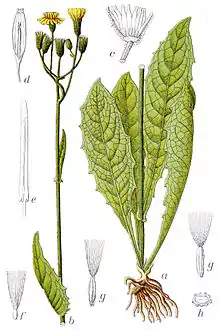Crepis paludosa
Crepis paludosa, the marsh hawk's-beard,[3] is a European species of flowering plant in the tribe Cichorieae of the family Asteraceae. It is widespread across much of Europe with isolated populations in Iceland, the Ural Mountains, and the Caucasus.[4][5]
| Crepis paludosa | |
|---|---|
 | |
| 1796 illustration[1] | |
| Scientific classification | |
| Kingdom: | Plantae |
| Clade: | Tracheophytes |
| Clade: | Angiosperms |
| Clade: | Eudicots |
| Clade: | Asterids |
| Order: | Asterales |
| Family: | Asteraceae |
| Genus: | Crepis |
| Species: | C. paludosa |
| Binomial name | |
| Crepis paludosa | |
| Synonyms[2] | |
|
Synonymy
| |
This herbaceous perennial is found beside shady streams and in other damp shady places.[6] The inflorescence is around 15–25 millimetres (0.6–1.0 in) in diameter.[6] The upper leaves clasp the stem with pair of rounded basal lobes. It is a much more robust plant than smooth hawksbeard, Crepis capillaris, with which it is sometimes confused. The Flower heads are yellow and the flower buds are covered with black gland-hairs.[6]
Conservation
Crepis paludosa is a component of Purple moor grass and rush pastures, a type of Biodiversity Action Plan habitat in the UK. It occurs on poorly drained neutral and acidic soils of the lowlands and upland fringe. It is found in the South West of England, especially in Devon.
References
- Figure 55 from Deutschlands Flora in Abbildungen; Author: Johann Georg Sturm; Painter: Jacob Sturm
- The Plant List, Crepis paludosa (L.) Moench
- BSBI List 2007 (xls). Botanical Society of Britain and Ireland. Archived from the original (xls) on 2015-06-26. Retrieved 2014-10-17.
- Altervista Flora Italiana, Radicchiella di palude, Crepis paludosa (L.) Moench includes photos and European distribution map
- Wilde Planten en Nederland en België in Dutch with photos and distribution map
- Skye Flora site.
External links
- Irish Wildflowers
- Cxech Botany in Czech with photos
- Tela Botanica in French with photos and French distribution map